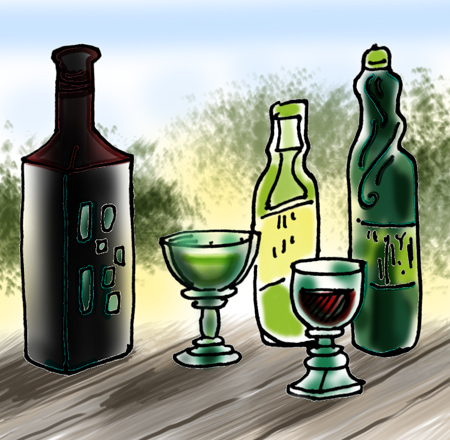Wines of Keiliana
Erbesta 14, 231 A.C. (After the Crossing)
By Terna Takveri, Wine Editor

The island of Trinacria was one of the first places that the Noantri landed in the Great Migration. Rather than one built-up terminus for the Great Gate, there were a scattering of outlets, through which came the peoples assigned to this rugged wilderness: first, the Pelasgians, and later, the Keilians. In the first century, even before the official First Coming, the Keilians drove the Pelasgians into the hinterlands and onto the mainland, claiming the best fishing and timber resources for themselves. And they also claimed the best places for vineyards.
The Keilians were one of the least "developed" peoples among the Noantri, with a pre-technological, tribal culture that was organized into large clans and their sub-groups. They were adapted for hunting, fishing, and agriculture, and to the advantage of all of New Earth, they possessed advanced viticultural knowledge as well as vine stock.
The First Comers had already identified several native grape varieties in the area, and the Keilians planted their own on slopes they cleared with their axes and saws and beasts of burden. The Noantri Old World grapes took root and grew in New Earth, and even though they were side by side with the local grapes, their genetics were too different to hybridize. In general the Noantri Old World grapes are much less productive than the cultivated local varieties. In the early decades after the Crossing, you could still find bottles of Noantri Old World wine that had been taken through the Gateway in private collections, and wine explorers documented the comparison between the first Keilian New World vintages and these precious but still drinkable relics from the world left behind.
Nowadays there's no way to tell what those Old World wines tasted like, and the terroir of the New World has forever changed the output of the Noantri Old World vines. But the Keilians, using primitive technology, have managed to produce some of the best wines of the West from their cultivation of the local vines. It's quite a change from the sun-drenched Nilotic wines of the Khemaru, which we are used to finding in inexpensive abundance. Keilian wineries are all owned by families, not government consortia, and if you don't live in or visit Trinacria, it's quite difficult to obtain any of the wines of "Keiliana."
I'll concentrate on one typical red and one white. Probably the most characteristic Keilian red is the "Atra D'Arna" which is named after one of the major winemaking tribes, the Arna. "Atra" means "black" and the native grapes are a pearly black in color. "Atra D'Arna" grows best on the south-facing slopes of the "Sun Coast", in places like Noto and even towards the suburbs of Surakosai. It's worth getting yourself a Keilian guide to venture into the back country to visit the more remote wineries, but you can get a feel for these wines at the more accessible wineries off the Gela Road, the Intermountain Passageway, or even the Catania Coastal Highway.
"Atra D'Arna" is a robust full-bodied wine with a deep blackish-red color. The aroma has a foresty tang and the wine is full of dark fruit and berry flavors with a hint of pine resin on the finish. The Keilians still line some of their barrels with pine resin, though Atra is also available in an un-resinated (and to me, less interesting) version. Atra D'Arna is a perfect companion for roast game such as the wild boar that the Keilians often bring to the restaurants of Surakosai in the fall hunting season.
"Menempsa" is a clear, dry white, again from native grapes. It has a touch of floral aroma and a definite citrus quality but stays dry through the long finish, with a nice herbal underlayer. I'd drink Menempsa with the abundant seafood and fish that our Keilian neighbors harvest from the Middle Sea.
The Keilians may be considered "primitive" by the more urban residents of our island but because they preserve their old technologies, we can enjoy wines that have more individuality and variety, even though they don't travel well. Another benefit of the less-developed tribes is that they produce aesthetically pleasing craft items, especially textiles and hand-blown and shaped glassware. The illustration above shows some of the fanciful wine bottles and glasses made by Keilian craftsmen. Atra D'Arna is often bottled in tall black squared-off bottles with colored glass symbols melted onto the surface.
Around this time, if you go to Keilian wine country, you will see many of the colorful and festive customs that they observe at the harvest and first crushing. You may even see the "wine witch" moving among the wooden barrels and vats, saying her prayers and casting spells. They say that the wine will not ferment correctly without the presence of the proper spells. Nouetic investigators have looked into the process, and have speculated that the "wine witch's" spells induce a micro-telekinetic organic reaction that selects for the desired level of fermentation and yeast growth. Other experts say that the wine witch's work is purely theatrical. I say, as long as the wine is good, let the witch do her work.
Posted at 3:30 am | link
Archives:
October 2011 (1)
September 2011 (1)
September 2010 (1)
July 2010 (2)
June 2010 (1)
May 2010 (2)
April 2010 (14)
March 2010 (3)
June 2009 (1)
May 2009 (1)
April 2009 (3)
March 2009 (2)
February 2009 (4)
January 2009 (4)
August 2008 (1)
April 2008 (2)
March 2008 (2)
February 2008 (4)